French bread is a popular and delicious bread choice, but if you’re watching your carb intake, it’s important to know the nutritional information. One medium slice of French bread (4″ x 2 1/2″ x 1 3/4″) contains 33.2 grams of total carbs, with 31.8 grams of net carbs. It also has 1.4 grams of fiber, 28.3 grams of starch, and 3 grams of sugar. French bread is relatively low in fat, with 1.6 grams of fat per serving. It’s a good source of protein, with 6.9 grams in each slice.
In addition to its carb content, French bread also provides other nutrients. It contains calcium, iron, magnesium, phosphorus, potassium, and selenium, among other minerals. It’s also a source of vitamins B1, B2, B3, B5, B6, and folate.
French bread is versatile and can be enjoyed in various forms, such as toasted, as a dinner roll, or in baked products like pizza or baguettes. It can be paired with a variety of spreads or used as a base for sandwiches or croutons.
If you’re interested in making your own French bread, a recipe for a delicious batard bread is provided. This batard bread is made with a sourdough starter and requires only four main ingredients: bread flour, water, salt, and olive oil. It’s a wholesome and flavorful option that can be customized with added ingredients like plum jam or apricot preserves.
To make the batard bread, you’ll need some basic kitchen equipment, including a heavy cast iron Dutch oven, a banneton basket or bread-proofing basket, a razor or sharp knife for scoring the dough, and parchment paper for easy handling.
The recipe includes step-by-step instructions for creating the sourdough starter, autolysing the dough, adding salt, folding the dough, pre-shaping, final shaping, and baking the bread to perfection.
Key Takeaways:
- French bread contains 33.2 grams of total carbs and is relatively low in fat.
- It provides a good source of protein and various minerals and vitamins.
- French bread can be enjoyed in different forms and paired with various spreads.
- A homemade batard bread recipe is provided, offering a customizable and delicious option.
- Basic kitchen equipment is necessary to make your own French bread at home.
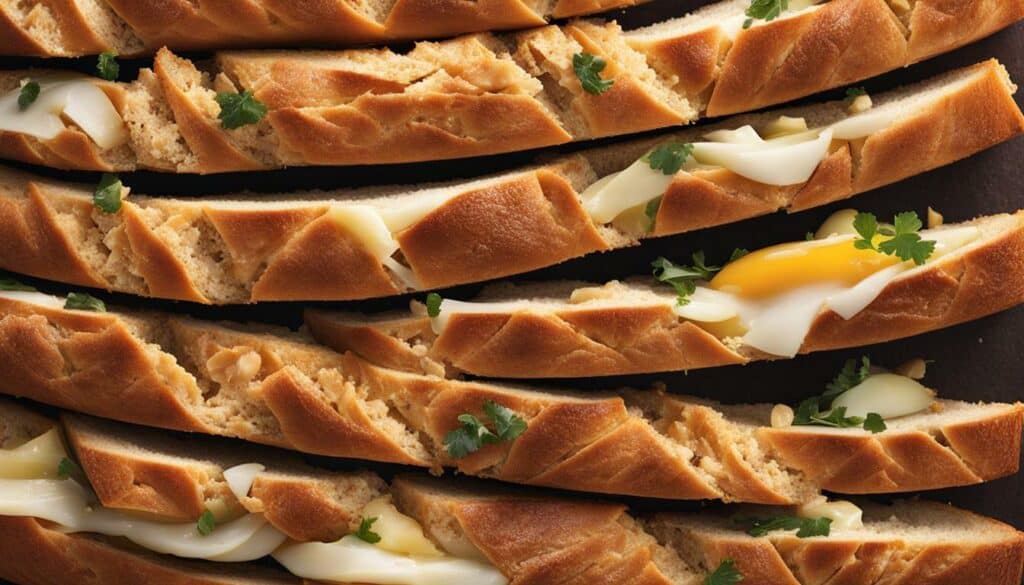
The Carbohydrate Content of French Bread
One medium slice of French bread (4″ x 2 1/2″ x 1 3/4″) contains 33.2 grams of total carbs, with 31.8 grams of net carbs. It’s important to note that net carbs are calculated by subtracting the fiber content from the total carbs. In the case of French bread, there is 1.4 grams of fiber per serving, resulting in the net carb value.
Fiber is a type of carbohydrate that the body cannot digest, so it doesn’t contribute to blood sugar levels. It can also help promote feelings of fullness and support digestive health. While French bread isn’t particularly high in fiber, every gram counts towards a balanced diet.
| Carbohydrate Content | Value per serving |
|---|---|
| Total Carbs | 33.2 grams |
| Net Carbs | 31.8 grams |
| Fiber | 1.4 grams |
| Starch | 28.3 grams |
| Sugar | 3 grams |
French bread is relatively low in fat, with only 1.6 grams per serving. It’s a good option for those looking for a lighter bread choice. Additionally, it provides a decent amount of protein, with 6.9 grams per slice. Protein is essential for building and repairing tissues, supporting immune function, and maintaining overall health.
While French bread can be a tasty addition to a meal or snack, it’s important to consider portion sizes and overall dietary goals. Pairing it with protein-rich foods, such as lean meats or eggs, can help balance the meal and provide a more sustained source of energy.
Other Nutritional Information of French Bread
In addition to its carbohydrate, fat, and protein content, French bread provides other essential nutrients. It contains minerals like calcium, iron, magnesium, phosphorus, potassium, and selenium. These minerals play various roles in the body, from maintaining strong bones to supporting the immune system.
French bread also offers vitamins, including B1 (thiamine), B2 (riboflavin), B3 (niacin), B5 (pantothenic acid), B6 (pyridoxine), and folate. These vitamins are involved in energy production, metabolism, and overall well-being.
French bread is a versatile bread that can be enjoyed in various forms. Whether you prefer it toasted with butter or as a base for a delicious sandwich, its light and crispy texture adds a delightful element to any meal. You can also use French bread to make croutons for salads or as a base for appetizers like bruschetta.
If you’re feeling adventurous and want to try making your own French bread at home, check out the provided recipe for a delicious batard bread. With just a few simple ingredients and some patience, you can enjoy the satisfaction of baking your own bread and savoring the homemade goodness.
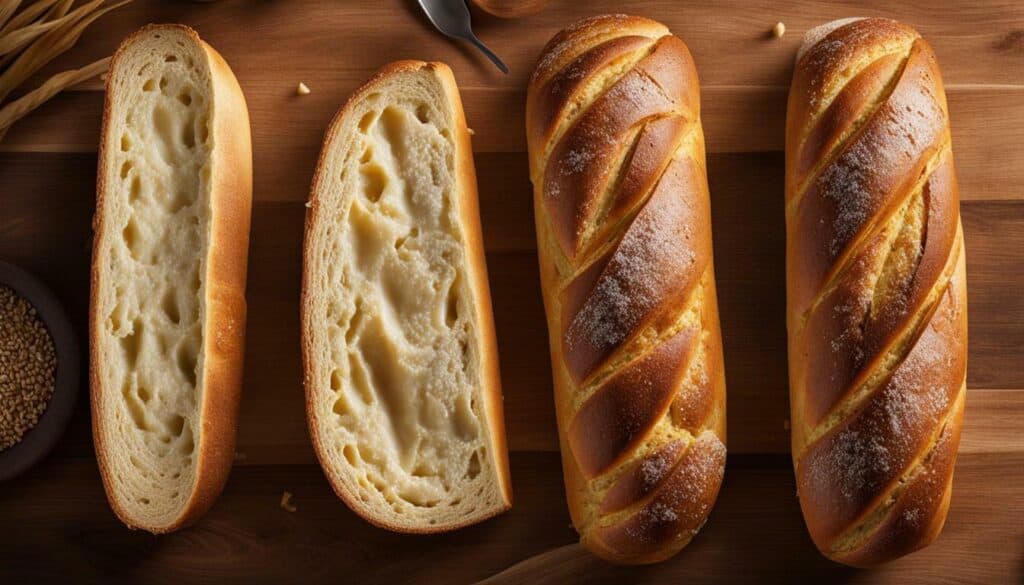
Apart from its carb content, French bread also offers various other nutrients, including calcium, iron, magnesium, and vitamins B1, B2, B3, B5, B6, and folate. These essential minerals and vitamins contribute to the overall nutritional value of French bread and can provide additional health benefits when included as part of a balanced diet.
Calcium is important for maintaining strong bones and teeth, while iron is crucial for healthy blood circulation. Magnesium plays a role in muscle function and supports nerve health. The B vitamins, including B1 (thiamine), B2 (riboflavin), B3 (niacin), B5 (pantothenic acid), B6 (pyridoxine), and folate, are all involved in energy production and cellular metabolism.
By incorporating French bread into your meals, you can boost your intake of these essential nutrients. Whether you enjoy it as a side to soups and stews, as part of a sandwich, or even as a base for homemade bruschetta, French bread can be a delicious and nutritious addition to your diet.
French Bread Nutritional Information:
| Nutrient | Amount per Serving (1 medium slice) |
|---|---|
| Carbohydrates | 33.2g |
| Fiber | 1.4g |
| Starch | 28.3g |
| Sugar | 3g |
| Fat | 1.6g |
| Protein | 6.9g |
| Calcium | 22.4mg |
| Iron | 1.6mg |
| Magnesium | 10.9mg |
| Vitamin B1 (Thiamine) | 0.1mg |
| Vitamin B2 (Riboflavin) | 0.1mg |
| Vitamin B3 (Niacin) | 0.6mg |
| Vitamin B5 (Pantothenic Acid) | 0.1mg |
| Vitamin B6 (Pyridoxine) | 0.1mg |
| Folate | 18.5mcg |
With its rich nutrient profile and delicious taste, French bread can be enjoyed as part of a well-balanced diet. So go ahead and savor a slice or two, knowing that you’re indulging in a bread that not only satisfies your taste buds but also provides essential nutrients for your body.
French Bread – A Low-Fat Option
French bread is relatively low in fat, with 1.6 grams of fat per serving. If you’re looking for a delicious and satisfying bread option that won’t weigh you down, French bread is a fantastic choice. Not only does it provide a satisfying crunch and chewy texture, but it also offers a relatively low-fat content compared to other bread varieties.
With just 1.6 grams of fat per serving, French bread allows you to indulge in a delectable bread option without worrying about excess fat intake. This makes it particularly appealing for those seeking a low-fat option in their diet.
One of the reasons why French bread is lower in fat compared to other bread types is its simple ingredient list. It typically consists of just flour, water, yeast, and salt, without the addition of fats like butter or oil. By using minimal fat in its preparation, French bread maintains its light and airy texture while still delivering on flavor.
| Nutrient | Amount per serving |
|---|---|
| Carbs | 33.2g |
| Fiber | 1.4g |
| Starch | 28.3g |
| Sugar | 3g |
| Fat | 1.6g |
| Protein | 6.9g |
French Bread Nutritional Information: French bread also offers a good source of protein, with 6.9 grams per serving. It contains essential minerals such as calcium, iron, magnesium, phosphorus, potassium, and selenium. Additionally, French bread provides vitamins B1, B2, B3, B5, B6, and folate, making it a well-rounded option for those looking to incorporate a variety of nutrients into their diet.
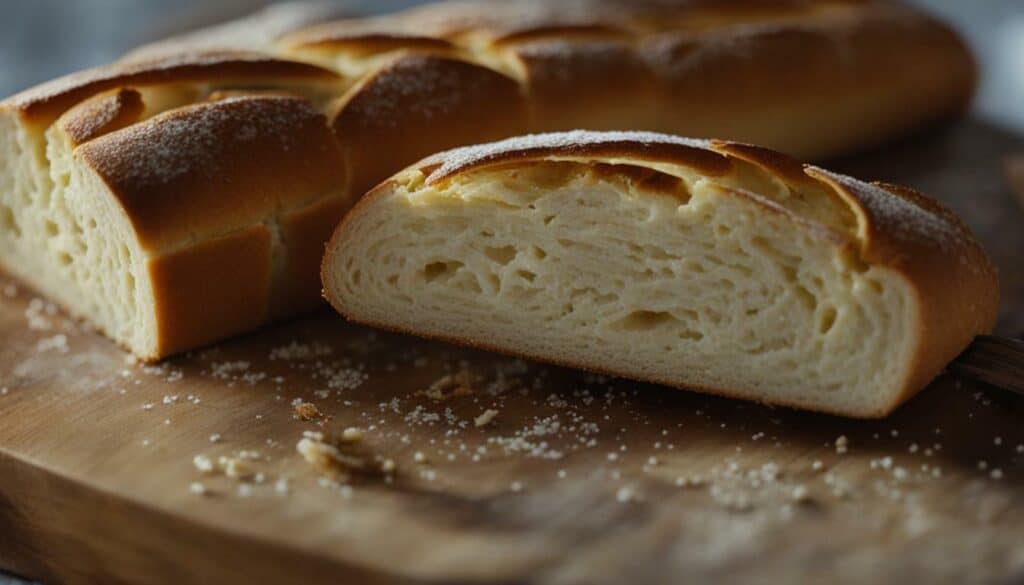
French bread calorie count: Enjoying a slice of French bread not only satisfies your taste buds but also fits well within a balanced diet. Each medium slice of French bread (4″ x 2 1/2″ x 1 3/4″) contains approximately 160 calories. This makes it a suitable option for individuals looking to manage their calorie intake while still enjoying a flavorful bread. Whether you’re using it as a base for sandwiches, toasting it with your favorite spreads, or incorporating it into your favorite recipes, French bread offers a tasty and low-fat choice that can be enjoyed guilt-free.
The Protein Power of French Bread
French bread is a good source of protein, with 6.9 grams in each slice. Protein is an essential nutrient that plays a crucial role in building and repairing tissues, promoting muscle growth, and supporting overall health. Including protein in your diet can help you feel satiated and maintain stable blood sugar levels.
Protein in French bread comes from the combination of wheat flour and yeast used in its preparation. These ingredients undergo a fermentation process that helps break down the proteins, making them more easily digestible. The protein content can vary slightly depending on the type of French bread and the brand you choose, but on average, you can expect around 6.9 grams per slice.
Adding a protein-rich spread or topping, such as lean meats, cheese, or nut butter, can further enhance the protein content of your French bread. This can be a great option for individuals who are looking for a quick and convenient way to increase their protein intake.
The Benefits of Protein in French Bread
Protein is vital for many functions in the body, including muscle growth, repair, and maintenance. It also plays a role in supporting a healthy immune system and promoting satiety, helping you feel full for longer periods. Incorporating protein into your meals and snacks can contribute to a balanced diet and overall well-being.
Keep in mind that while French bread provides a decent amount of protein, it should be consumed as part of a diverse and balanced diet that includes other protein sources, such as lean meats, fish, legumes, and dairy products. Pairing French bread with protein-rich ingredients can help create a more well-rounded meal and ensure you meet your daily protein requirements.
| Nutrient | Amount per slice |
|---|---|
| Protein | 6.9 grams |
| Carbs | 33.2 grams |
| Fat | 1.6 grams |
| Fiber | 1.4 grams |
“Protein is an essential nutrient that plays a crucial role in building and repairing tissues, promoting muscle growth, and supporting overall health.”
So, the next time you enjoy a slice of French bread, you can appreciate not only its delicious taste and texture but also its protein power. Just remember to include other protein-rich foods in your diet to ensure you’re meeting your nutritional needs. Bon appétit!
French bread can be enjoyed in different ways, such as in the form of baguettes, dinner rolls, or as a base for sandwiches or croutons. Its crispy exterior and soft, fluffy interior make it a versatile option for various culinary creations. Whether you prefer a classic baguette with butter or use slices of French bread to make a hearty sandwich, there are endless possibilities to savor this delicious bread.
If you’re looking for a quick and easy appetizer, try toasting thin slices of French bread and topping them with your favorite spreads, such as goat cheese, olive tapenade, or a bruschetta mixture. It’s a simple yet satisfying way to showcase the flavors of the bread and complement them with savory or tangy ingredients.
For a twist on traditional French toast, consider using French bread slices instead of regular bread. The thicker slices and airy texture of French bread add a delightful crunch and softness to this classic breakfast dish. Serve it with fresh fruits, syrup, or a dusting of powdered sugar for a delightful start to your day.
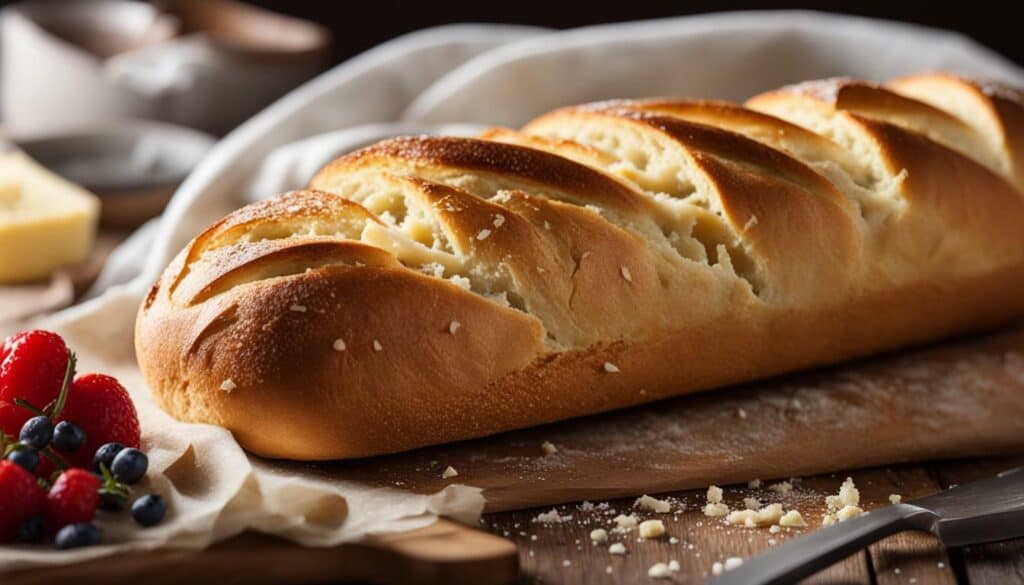
| French Bread Recipe Ideas | Ingredients |
|---|---|
| French Bread Pizza | French bread slices, pizza sauce, cheese, toppings of your choice (e.g., pepperoni, vegetables) |
| Bread Pudding | French bread slices, milk, eggs, sugar, vanilla extract, cinnamon, raisins or other desired mix-ins |
| Croutons | French bread slices, olive oil, garlic powder, salt, herbs (e.g., thyme, rosemary) |
French bread is a versatile ingredient that can turn a simple meal into something extraordinary. Its crusty exterior and soft interior lend themselves well to a variety of dishes. So next time you have a loaf of French bread, get creative and explore the numerous ways you can enjoy this delicious staple!
Making Your Own French Bread: A Delicious Recipe
If you’re interested in making your own French bread, we’ve got a delicious batard bread recipe for you. This recipe will guide you in creating a flavorful and wholesome bread that will rival any artisanal bakery. With just four main ingredients and a few essential kitchen tools, you can enjoy the satisfaction of baking your own homemade French bread.
The Ingredients and Equipment You’ll Need
To make this batard bread, you’ll need:
- 3 ⅓ cups of bread flour
- 2 ⅓ cups of water
- 2 teaspoons of salt
- 1 tablespoon of olive oil
In addition to the ingredients, you’ll require a few essential kitchen tools:
- A heavy cast iron Dutch oven
- A banneton or bread-proofing basket
- A razor or sharp knife for scoring the dough
- Parchment paper for easy handling
Step-by-Step Instructions for Homemade French Bread
Follow these steps to create your own homemade batard bread:
- Step 1: Creating the Sourdough Starter
Mix 1 cup of bread flour with ½ cup of water in a large bowl. Cover the bowl with a clean cloth and let it sit at room temperature for 24 hours to ferment and develop the sourdough starter. - Step 2: Autolysing the Dough
Add the remaining 2 ⅓ cups of bread flour, 1 ⅓ cups of water, and 2 teaspoons of salt to the sourdough starter. Mix the ingredients until the dough comes together. Cover the bowl and let it rest for 30 minutes to allow the flour to fully hydrate. - Step 3: Adding Salt and Folding the Dough
Sprinkle the 2 teaspoons of salt evenly over the dough. Fold the dough over itself several times to incorporate the salt. Cover the bowl and let it rest for 30 minutes. - Step 4: Pre-shaping and Final Shaping
Transfer the dough onto a lightly floured surface. Pre-shape it into a round shape, then cover it and let it rest for 15 minutes. After the rest, shape the dough into a batard shape by folding the sides towards the center and rolling it into a log. Place the shaped dough into a floured banneton or bread-proofing basket, seam side up. - Step 5: Baking the Bread
Preheat your oven to 475°F (245°C) with the cast iron Dutch oven inside. Once the oven is preheated, carefully remove the hot Dutch oven from the oven. Line the Dutch oven with parchment paper and gently transfer the shaped dough into it, seam side down. Cover the Dutch oven with its lid and bake for 30 minutes. After 30 minutes, remove the lid and continue baking for an additional 20-25 minutes, or until the bread is golden brown and sounds hollow when tapped on the bottom.
Enjoy the delightful aroma and taste of your homemade French bread. Slice it and serve it warm with butter or your favorite spreads. Bon appétit!
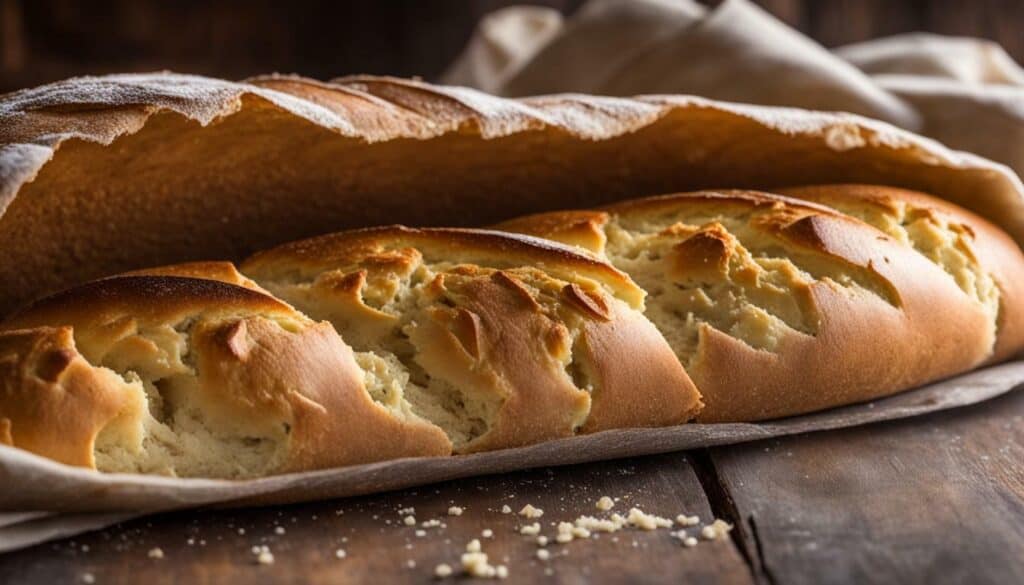
To make the batard bread, you’ll need basic kitchen equipment and four main ingredients: bread flour, water, salt, and olive oil.
Here’s a list of the essential equipment:
- A heavy cast iron Dutch oven
- A banneton basket or bread-proofing basket
- A razor or sharp knife for scoring the dough
- Parchment paper for easy handling
These tools will help you achieve the perfect texture and shape for your homemade batard bread.
Now, let’s take a closer look at the ingredients:
| Ingredients | Quantity |
|---|---|
| Bread flour | 500 grams |
| Water | 350 milliliters |
| Salt | 10 grams |
| Olive oil | 15 milliliters |
These ingredients are readily available and will help you achieve that classic home-baked taste.
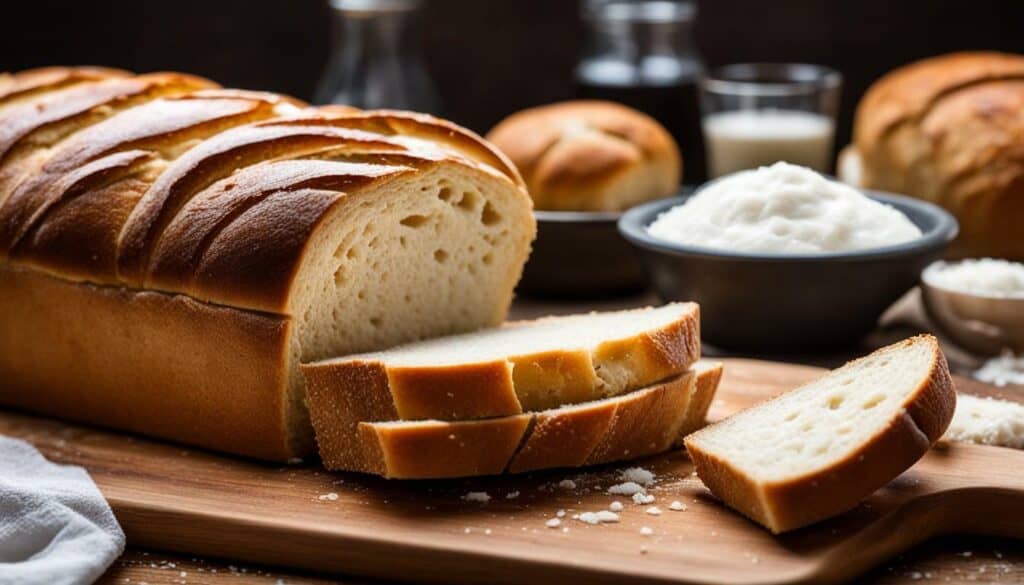
With the right equipment and ingredients, you’re all set to embark on your homemade batard bread-making journey. Get ready to enjoy the delicious aroma and taste of freshly baked French bread!
Step-by-Step Instructions for Homemade French Bread
The recipe includes instructions on creating the sourdough starter, autolysing the dough, adding salt, folding the dough, pre-shaping, final shaping, and baking the bread. Follow these steps to make your own delicious batard bread at home:
- Create the Sourdough Starter: Begin by combining flour and water in a jar or bowl. Stir until well mixed, cover loosely, and let it sit for 24 hours at room temperature.
- Autolyse the Dough: In a large mixing bowl, combine bread flour, water, and the sourdough starter. Mix until just combined, cover with a tea towel, and let it rest for 30 minutes.
- Add Salt: Sprinkle salt over the dough and use your hands to incorporate it evenly. Cover the bowl and let it rest for another 30 minutes.
- Fold the Dough: Wet your hands with water and perform a series of folds on the dough. This helps develop gluten and strengthen the dough. Repeat the folding process every 30 minutes for a total of 3 to 4 folds.
- Pre-shape and Final Shape: Divide the dough into two parts and shape each portion into a rough oval shape. Let them rest for 10 minutes, then shape them into batards by folding the dough in on itself from both sides, creating a seam. Place the shaped loaves on a floured surface.
- Baking the Bread: Preheat the oven to 450°F (232°C) and place a cast iron Dutch oven inside to preheat as well. Once the oven and Dutch oven are hot, carefully transfer the shaped batards into the preheated Dutch oven, seam side down. Score the top of each loaf with a razor or sharp knife to allow for expansion. Cover the Dutch oven and bake for 20 minutes. Remove the lid and bake for an additional 20 minutes or until the bread is golden brown.
Once the bread is baked, transfer it to a wire rack to cool completely before slicing and enjoying. The result is a crusty and flavorful French bread that you can proudly serve to family and friends.
Make It Your Own
While the basic batard bread recipe is delicious on its own, you can experiment with customization by adding various ingredients. Consider incorporating herbs like rosemary or thyme into the dough for a savory twist. Alternatively, you can mix in dried fruits like raisins or cranberries for a touch of sweetness. Get creative and let your taste buds guide you!
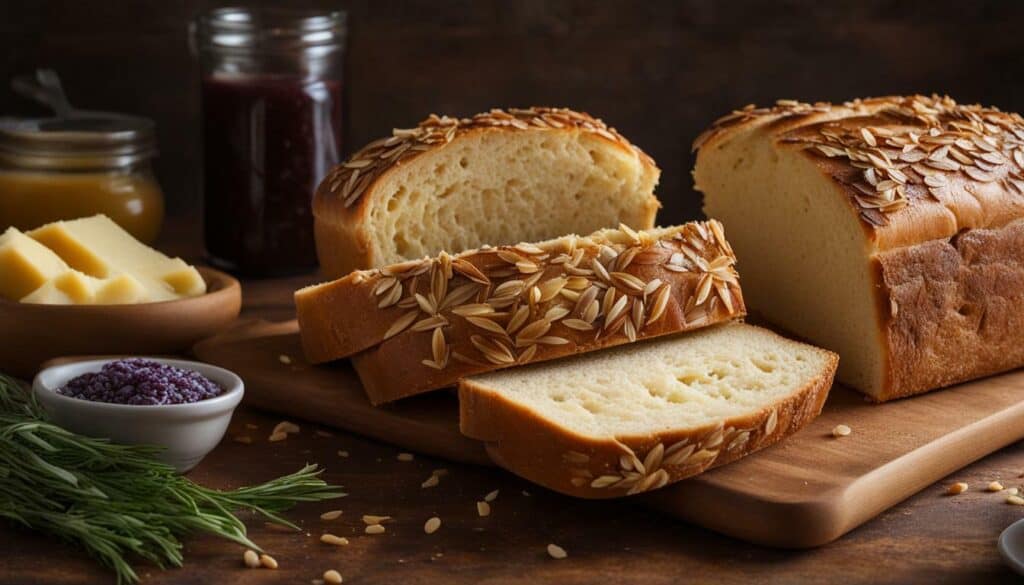
| Ingredient | Quantity |
|---|---|
| Bread flour | 450 grams |
| Water | 340 grams |
| Sourdough starter | 100 grams |
| Salt | 9 grams |
Table: Ingredients for Homemade French Bread
Customize Your Homemade French Bread
The batard bread recipe can be customized with ingredients like plum jam or apricot preserves for a unique twist. By adding these fruity fillings to your homemade French bread, you’ll infuse it with a burst of flavor that perfectly balances the crusty exterior and soft interior of the bread.
Another tasty option for customization is to sprinkle sesame seeds, poppy seeds, or dried herbs like rosemary or thyme on top of the bread before baking. These additions not only add visual appeal but also bring a delightful aroma and extra taste to each bite.
If you prefer a savory twist, consider mixing in shredded cheese, minced garlic, or chopped olives into the dough. This will create a savory French bread that pairs perfectly with soups, stews, or a charcuterie board.
Remember, when customizing your homemade French bread, the possibilities are endless. Get creative and experiment with different ingredients to discover your own signature variation of this classic bread.
Try this delicious variation:
- Ingredients:
- Plum jam or apricot preserves
- Sesame seeds, poppy seeds, or dried herbs
- Shredded cheese, minced garlic, or chopped olives
- Instructions:
- Follow the step-by-step instructions for making your homemade French bread.
- After shaping the dough, spread a thin layer of plum jam or apricot preserves on top of the bread.
- Sprinkle sesame seeds, poppy seeds, or dried herbs over the jam or preserves.
- If desired, mix shredded cheese, minced garlic, or chopped olives into the dough during the folding process.
- Continue with the remaining steps, including the final shaping and baking.
- Enjoy your customized French bread with your favorite spreads or as a standalone treat!
Baking your own French bread allows you to savor the delight of freshly baked bread and control its carb content. There’s something truly magical about the aroma that fills your kitchen as the bread bakes to a golden brown crust, creating a warm and comforting atmosphere. Whether you’re a seasoned baker or a novice in the kitchen, making homemade French bread is a rewarding experience that yields delicious results.
Not only does homemade French bread taste amazing, but it also allows you to have control over the quality of ingredients used. You can choose to opt for organic, whole grain flours and reduce the amount of added sugars, ensuring a healthier and more wholesome loaf. And the best part? You can customize your bread with flavors and add-ins that suit your taste preferences.
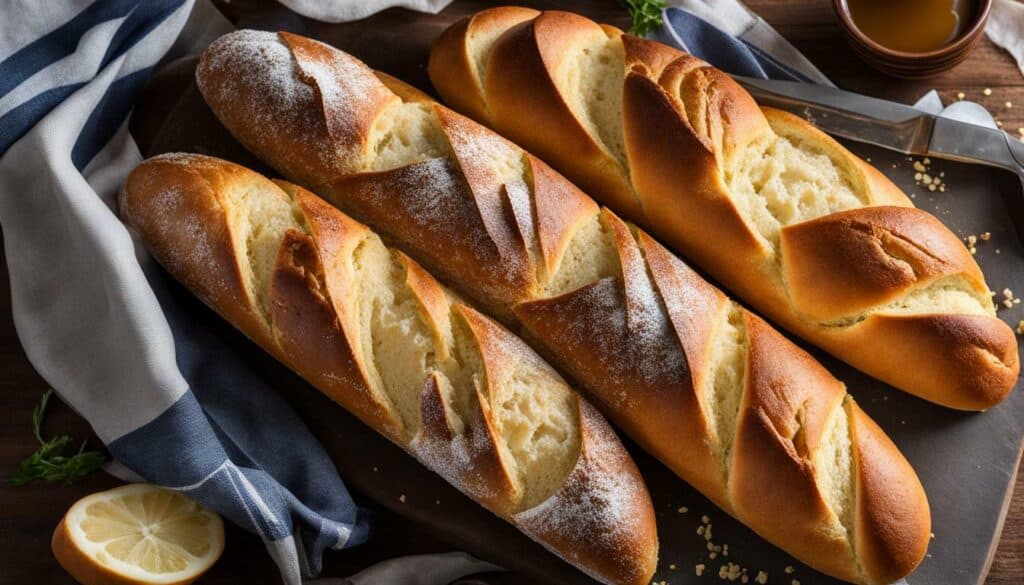
Imagine biting into a freshly baked slice of warm, crusty French bread, with a soft and chewy interior that’s full of flavor. It pairs perfectly with soups, stews, or a simple spread of butter. You can also transform it into mouthwatering garlic bread or use it as a base for bruschetta. The possibilities are endless, and each slice is a true delight for your taste buds.
So why not embark on a culinary adventure in your very own kitchen and experience the joy of baking homemade French bread? Not only will you have a delicious loaf to enjoy, but you’ll also have the satisfaction of knowing that you created something special from scratch.
Take a look at this table for a summary of the carb content in homemade French bread:
| Carbohydrate content per serving | Fiber per serving | Net carbs per serving |
|---|---|---|
| 20 grams | 2 grams | 18 grams |
This table provides an overview of the approximate carb content of homemade French bread per serving. It’s important to note that these values may vary slightly depending on the specific recipe and ingredients used. Nevertheless, homemade French bread can be a delicious and satisfying addition to your low-carb lifestyle.
Conclusion
French bread provides a tasty carb option, and with the provided recipe, you can even try making your own delicious batard bread at home.
French bread is a popular and delicious bread choice, but if you’re watching your carb intake, it’s important to know the nutritional information. One medium slice of French bread (4″ x 2 1/2″ x 1 3/4″) contains 33.2 grams of total carbs, with 31.8 grams of net carbs. It also has 1.4 grams of fiber, 28.3 grams of starch, and 3 grams of sugar. French bread is relatively low in fat, with 1.6 grams of fat per serving. It’s a good source of protein, with 6.9 grams in each slice.
In addition to its carb content, French bread also provides other nutrients. It contains calcium, iron, magnesium, phosphorus, potassium, and selenium, among other minerals. It’s also a source of vitamins B1, B2, B3, B5, B6, and folate.
French bread is versatile and can be enjoyed in various forms, such as toasted, as a dinner roll, or in baked products like pizza or baguettes. It can be paired with a variety of spreads or used as a base for sandwiches or croutons.
If you’re interested in making your own French bread, a recipe for a delicious batard bread is provided. This batard bread is made with a sourdough starter and requires only four main ingredients: bread flour, water, salt, and olive oil. It’s a wholesome and flavorful option that can be customized with added ingredients like plum jam or apricot preserves.
To make the batard bread, you’ll need some basic kitchen equipment, including a heavy cast iron Dutch oven, a banneton basket or bread-proofing basket, a razor or sharp knife for scoring the dough, and parchment paper for easy handling.
The recipe includes step-by-step instructions for creating the sourdough starter, autolysing the dough, adding salt, folding the dough, pre-shaping, final shaping, and baking the bread to perfection.
Overall, French bread provides a tasty carb option, and with the provided recipe, you can even try making your own delicious batard bread at home.
FAQ
Q: What is the carbohydrate content of French bread?
A: One medium slice of French bread (4″ x 2 1/2″ x 1 3/4″) contains 33.2 grams of total carbs, with 31.8 grams of net carbs.
Q: What other nutrients does French bread provide?
A: French bread contains calcium, iron, magnesium, phosphorus, potassium, selenium, and vitamins B1, B2, B3, B5, B6, and folate.
Q: Is French bread high in fat?
A: French bread is relatively low in fat, with 1.6 grams of fat per serving.
Q: How much protein does French bread contain?
A: Each slice of French bread provides 6.9 grams of protein.
Q: How can French bread be enjoyed?
A: French bread can be enjoyed toasted, as a dinner roll, or in baked products like pizza or baguettes. It can also be paired with spreads or used as a base for sandwiches or croutons.
Q: How can I make my own French bread?
A: A delicious batard bread recipe is provided, which requires bread flour, water, salt, and olive oil as the main ingredients.
Q: What equipment do I need to make homemade French bread?
A: You’ll need a heavy cast iron Dutch oven, a banneton basket or bread-proofing basket, a razor or sharp knife for scoring the dough, and parchment paper for easy handling.
Q: What are the step-by-step instructions for making homemade French bread?
A: The recipe includes step-by-step instructions for creating the sourdough starter, autolysing the dough, adding salt, folding the dough, pre-shaping, final shaping, and baking the bread.
Q: Can I customize my homemade French bread?
A: Yes, you can customize your homemade French bread by adding ingredients like plum jam or apricot preserves.
Q: What is the joy of homemade French bread?
A: Baking and enjoying your own homemade French bread provides a sense of satisfaction and delight.
Are Carnitas a Healthy Option in Terms of Calories?
Are Carnitas a Healthy Option in Terms of Calories? If you’re looking for a healthy guide to carnitas, you might be pleasantly surprised. With a focus on lean cuts of pork and minimal added fats, carnitas can be a delicious and satisfying choice. However, be mindful of portion sizes and the accompaniments you choose, as they can significantly impact the overall calorie content. Balance is key when enjoying this flavorful Mexican dish.

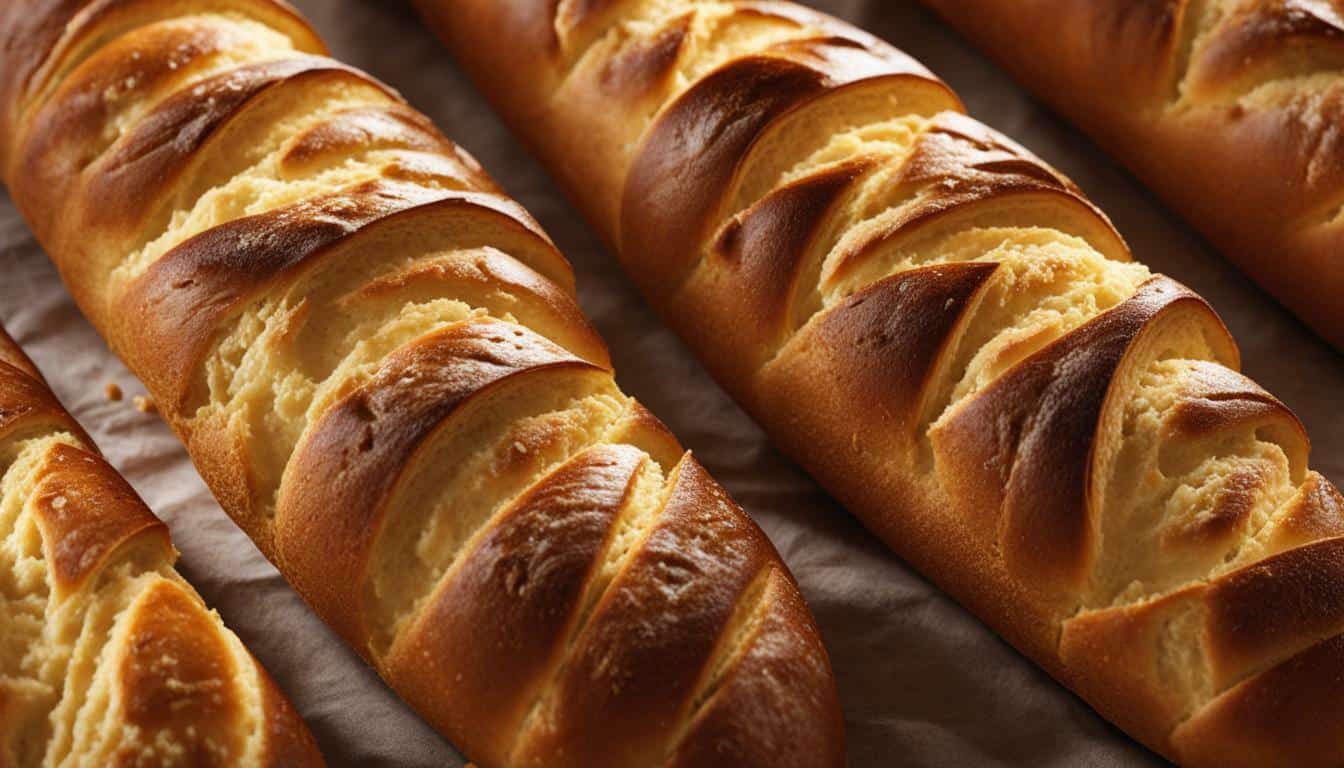



Leave a Reply